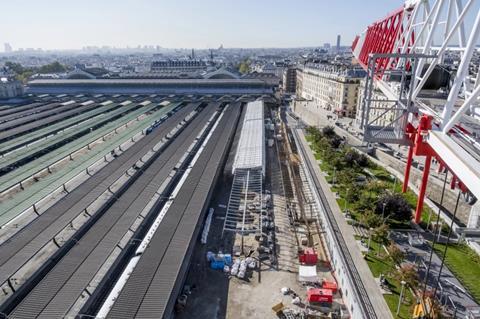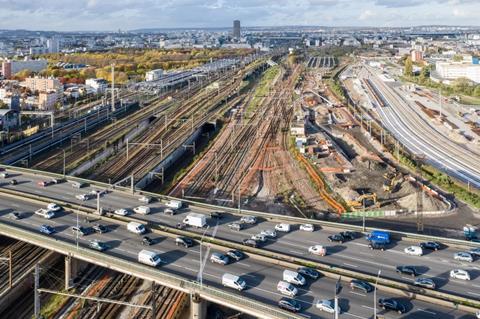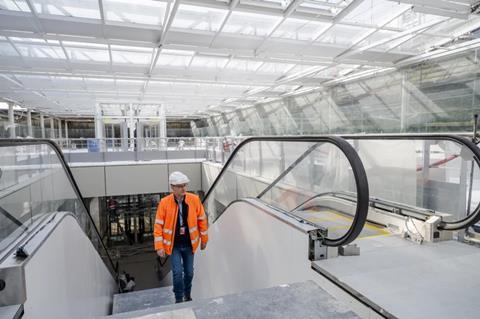
FRANCE: The French government has paid compensation worth €30∙2m to Hello Paris, the designated operator of the long-planned CDG Express service between Paris Est station and Charles-de-Gaulle airport, in recognition of a further delay in opening, now expected to be in March 2027.
First planned during the 1990s, the €2∙2bn project was originally scheduled for completion in 2006. A series of delays meant that the scheme made slow progress, with a Declaration of Public Utility eventually granted in 2008. The government then abandoned the proposed delivery model of a ‘global concession’ in 2011, halting the project completely.
The concept was resurrected in 2014 with SNCF Réseau and airport operator Groupe ADP forming the CDG Express Études company. An updated DUP was subsequently granted, and a government loan was agreed in the 2018 budget, allowing the formation of a group to manage the project. This consisted of SNCF Réseau, Groupe ADP and Caisse de Dépôts et Consignations, which adopted the CDG Express nomenclature in 2019. Tractebel was appointed as Independent Technical Expert.
Work began in the same year, when the government signed a contract with the future operator Hello Paris, formed of Keolis and RATP Dev. Completion was planned in 2023 in time for the 2024 Olympic Games being staged in Paris.
The original agreement was for a five-year pre-opening period and 15 years of operation through to the end of 2038. Legal challenges delayed the start of construction, and by 2019 it was apparent that the target date for opening could not be met.
In 2022, the Administrative Court of Appeal of Paris definitively approved construction of the project, work having been suspended by the local court in Montreuil in November 2020. The operating agreement has now been amended to take account of the latest delay, which is partly attributable to the Covid pandemic.
Route

CDG Express is intended to relieve the existing RER Line B stopping service from Paris Nord to the airport, which is the second busiest in Europe. The planned service would provide a non-stop train that takes just 20 min for the 32 km journey through the suburbs of the French capital. Services are to depart at 15 min intervals, with the route commencing at Paris Est rather than nearby Nord. Trains will operate between 05.00 and midnight.
The route has been divided into eight sections. These include 8 km of new construction: a 1 km spur linking Est with Line B heading north out of Nord, and a 7 km branch from Villeparisis Mitry-le-Neuf taking the line into the airport; these two segments were originally costed at €1∙7bn. Turnback sidings for possible short workings in the event of disruption are being provided at Le Bourget and La Plaine Stade-de-France.
On the 24 km trunk section which shares tracks with services from Paris Nord to Laon, CDG Express trains will use the two tracks on the south side of the alignment. These are being progressively modernised and resignalled for 140 km/h running, with an additional €537m spent on upgrading Line B in this corridor.
At Villeparisis a burrowing junction takes the new line northwards to follow the alignment of the LGV Interconnexion high speed line before it enters a 400 m cut-and-cover tunnel below runways 2 and 4 to reach the terminal station at CDG 2; the tunnelling work started in 2016. The CDG Express terminal station with two platforms forms an addition to the existing CDG Terminal 2 station served by TGVs.
The final 1∙3 km double-track section into the terminal makes use of concrete slab track and includes nine sets of points and a number of escape shafts or passages. With trackwork complete, installation of the 25 kV 50 Hz overhead electrification began in June.
Work over the final 5∙8 km of line into the airport from Mitry-Moiry was carried out by a group consisting of Valerian, Colas Rail, Colas Rail Infra Services, Spie Batignolles Génie Civil, Demathieu Bard, Egis Rail and Fer Expert.
Complex exit from Paris

Platforms 2, 3 and 4 at Paris Est have been rebuilt to accommodate the CDG service, with platform 2 designated as a storage or layby siding for back-up in the event of service disruption. For the first 2 km, CDG trains will use two tracks on the west side of the station throat, diverging at rue de l’Évangile in an open cut and a 610 m cut-and-cover tunnel through the CAP18 industrial area to La Chapelle. The line then curves sharply west then eastwards, crossing RER lines B and D via a flying junction at Saint-Denis to join the southern pair of Line B tracks.
Complex work has included reconstruction of five road underbridges dating from the 19th century at Porte de la Chapelle; the iron structures have been replaced by a modern steel and concrete design that is expected to reduce noise levels by 10 dB. The opportunity has been taken to simplify the layout in this area and surplus track has been removed.
Work is continuing in the Saint Denis area where CDG Express trains will join the lines serving Paris Nord. A 143 m long Warren truss bridge is being built to span the tracks used by RER lines B and D; this replaces a structure dating from 1894. Much of the work was due to take place on October 25-27, with lines also due to be closed over two weekends in November and for four days in February 2025. This will be followed by tracklaying at the end of March and in April before the old bridge is demolished in July, allowing the new structure to be brought into service on August 15 2025.
Rolling stock

Hello Paris has ordered six four-car Z44000 and seven six-car Z61000 Coradia Liner dual-system EMUs from Alstom at a cost of €160m; the order was transferred to CAF after Alstom divested the Coradia range.
The first two of these were completed at Reichshoffen in 2022 and taken in September that year to the test centre at Tronville-en-Barrois southeast of Bar-le-Duc; by July this year they had been placed in store at the port of Strasbourg. Hello Paris says the train interiors are to feature ample luggage space and ‘will be unique to the CDG Express line’, with real-time information about flights provided to passengers.
Always controversial, especially along the routes of RER lines B and E where local officials were concerned that the airport express would reduce capacity for suburban trains, the project has been criticised as a train ‘for the rich’. This is partly on account of the proposed premium fare, now likely to be €24.
On the other hand, RER B is currently used by 30% of passengers travelling to and from the airport, meaning that it becomes heavily overcrowded with airport traffic peaking at the same time as commuter travel. With much of this traffic likely to switch to CDG Express, there should be some relief for Line B passengers. The scheme is also expected to reduce road traffic between Paris and the airport, with road’s modal share predicted to fall from 56% currently to around 40%.

















